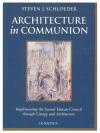1
/
of
1
Architecture in Communion: Implementing the Second Vatican Council Through Liturgy and Architecture
Architecture in Communion: Implementing the Second Vatican Council Through Liturgy and Architecture
Regular price
$56.90
Regular price
Sale price
$56.90
Unit price
/
per
Tax included.
Amid the growing dissatisfaction with Catholic church architecture since the Second Vatican Council, and the general lack of clear and vibrant direction in liturgy, Architecture in Communion responds to the timely question of "How ought we build our churches?" Drawing upon the primary texts of the Second Vatican Council, recent papal encyclicals, curial documents, and the Catechism of the Catholic Church, Steven Schloeder examines this question in depth with regard to history, theology, iconography and symbolism, and the current debates both in Catholic thought and in architectural criticism.
Schloeder seeks not merely to analyze the question of why contemporary churches are so uninspiring and fulfilling, but he offers positive direction for the renewal of an authentic Catholic architecture- one that simultaneously respects the traditions of the Church's magnificent artistic heritage while advancing the vision of the Second Vatican Council.
Schloder's analysis reveals that there has been a certain history, a tradition, involved in crafting Catholic churches. It is a process that is rooted in Catholic thought and seeks to express Catholic values. Over the centuries there has evolved a rich, complex, and subtle "language" of liturgical and architectual symbols that seek to convey theological and liturgical ideas through the artful use of materials. This "language" was adopted by the builders of the early Church, and continued to develop across the patristic, medieval, renaissance, baroque, and revivalist ages. Much of this tradition has been outrightly discarded in the wake of the Modern movement in architecture and with the liturgical experimentation of this century.
Schloeder examines the church building with respect to the Second Vatican Council, and the relation of the Church to the arts and her artists. Each component of the church building is considered in terms of its theological, liturgical, canonical, communal, historical, and symbolic aspects. The key to the solution is to regain a sacramental understanding - which is set in sharp distinction to the materialism and existentialism of modernism in liturgy and architecture - seeing the liturgy and the arts as vehicles through which God communicates his love to mankind. Only as we regain this sacramental appreciation of ths liturgy, of the sacred image, and of the building as an icon, will we again be able to build churches that nurture the human spirit with beauty and meaning.
Schloeder seeks not merely to analyze the question of why contemporary churches are so uninspiring and fulfilling, but he offers positive direction for the renewal of an authentic Catholic architecture- one that simultaneously respects the traditions of the Church's magnificent artistic heritage while advancing the vision of the Second Vatican Council.
Schloder's analysis reveals that there has been a certain history, a tradition, involved in crafting Catholic churches. It is a process that is rooted in Catholic thought and seeks to express Catholic values. Over the centuries there has evolved a rich, complex, and subtle "language" of liturgical and architectual symbols that seek to convey theological and liturgical ideas through the artful use of materials. This "language" was adopted by the builders of the early Church, and continued to develop across the patristic, medieval, renaissance, baroque, and revivalist ages. Much of this tradition has been outrightly discarded in the wake of the Modern movement in architecture and with the liturgical experimentation of this century.
Schloeder examines the church building with respect to the Second Vatican Council, and the relation of the Church to the arts and her artists. Each component of the church building is considered in terms of its theological, liturgical, canonical, communal, historical, and symbolic aspects. The key to the solution is to regain a sacramental understanding - which is set in sharp distinction to the materialism and existentialism of modernism in liturgy and architecture - seeing the liturgy and the arts as vehicles through which God communicates his love to mankind. Only as we regain this sacramental appreciation of ths liturgy, of the sacred image, and of the building as an icon, will we again be able to build churches that nurture the human spirit with beauty and meaning.
Author
Schloeder, Steven
Related Collections:
Liturgy and the Mass
Bookshelf:
8E
Couldn't load pickup availability
Share
ISBN/Code: 898706319
View full details

